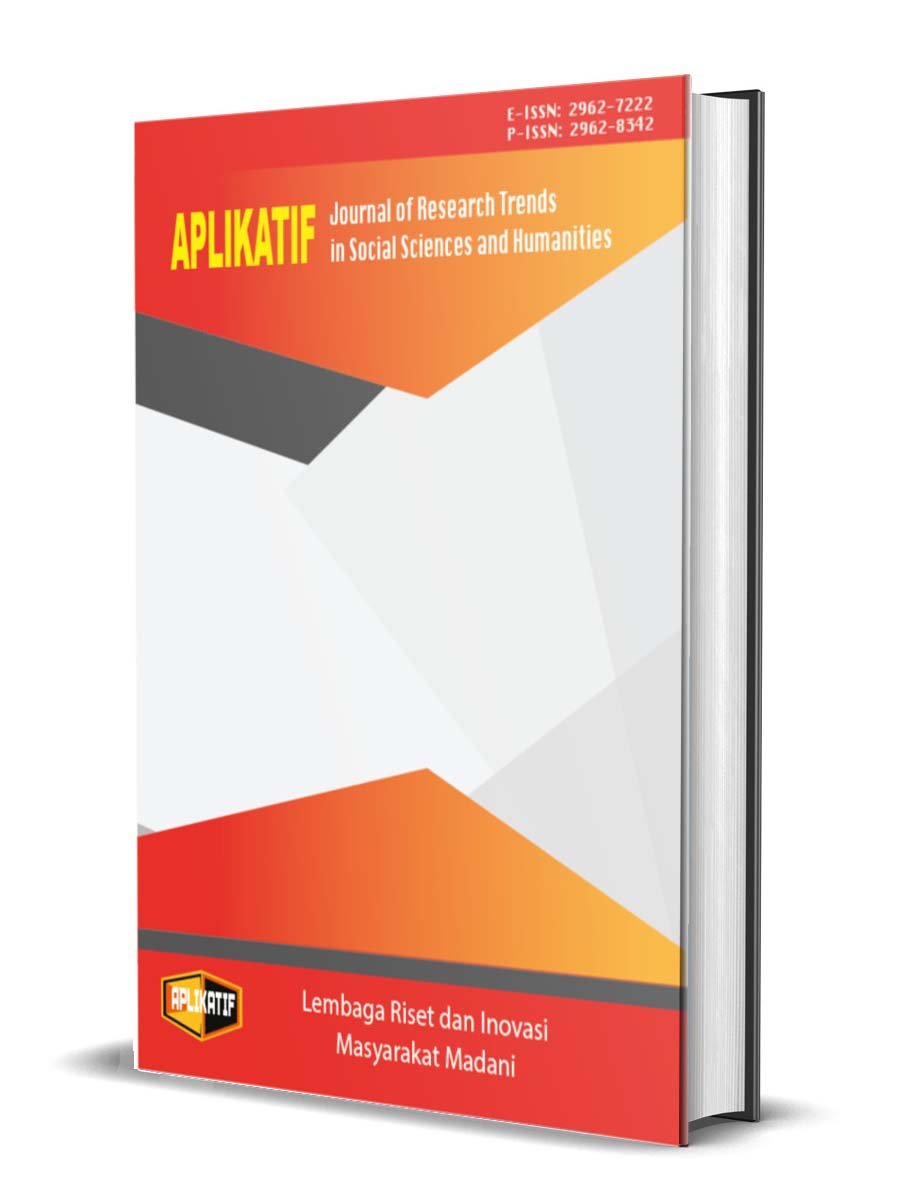English Communication Challenges among Indonesian Entrepreneurs: A Sociolinguistic Case Study
https://doi.org/10.59110/aplikatif.v4i1.542
Keywords:
English Pronunciation, Indonesian Entrepreneurs, Linguistic FeaturesAbstract
This research examines how Indonesian entrepreneurs use English, focusing on grammar, pronunciation, and vocabulary. As language plays a key role in communication, non-native speakers often adjust their speech based on their native language. This study employs a qualitative descriptive method, analyzing recorded interviews with 10 Indonesian entrepreneurs from diverse business sectors, including retail, services, and small-scale manufacturing. The findings reveal common grammatical errors, such as omitting plural markers (-s/-es), auxiliary verbs, and definite articles, which stem from structural differences between English and Indonesian. Pronunciation challenges include substituting the /v/ sound with /f/ and mispronouncing certain English phonemes. Additionally, vocabulary issues arise from direct translations from Indonesian, resulting in unnatural expressions. Entrepreneurs also engage in code-switching, switching between English and Indonesian to emphasize key ideas, express emotions, and navigate complex conversations. These patterns demonstrate the influence of the Indonesian language on English usage, emphasizing the need for targeted language training in grammar, pronunciation, and vocabulary. By addressing these challenges, educators and trainers can develop tailored strategies to help Indonesian entrepreneurs improve their English communication skills, enhancing their business interactions and opportunities in global markets.
Downloads
References
Ahmad, F. (2023). Code-switching and code-mixing among bilinguals: A sociolinguistic study. Pakistan Social Sciences Review, 7(III), 1–12. https://doi.org/10.35484/pssr.2023(7-iii)04
Agustina, L., & Chaer, A. (2004). Sosiolinguistik perkenalan awal. Rineka Cipta.
Birhan, A. (2019). An investigation into communicative English language needs and perceptions of English for specific purposes course: The case of Holy Trinity Theological College. International Journal of Education, 12(1), 26–33. https://doi.org/10.17509/ije.v12i1.17509
Bratsch‐Hines, M., Carr, R., Zgourou, E., Vernon‐Feagans, L., & Willoughby, M. (2020). Infant and toddler child‐care quality and stability in relation to proximal and distal academic and social outcomes. Child Development, 91(6), 1854-1864. https://doi.org/10.1111/cdev.13389
Carruthers, S. W. (2006). Pronunciation difficulties of Japanese speakers of English: Predictions based on a contrastive analysis. Hawaii Pacific University TESOL Working Paper Series, 4(2), 17–24.
Flores, G. (2005). The impact of medical interpreter services on the quality of health care: A systematic review. Medical Care Research and Review, 62(3), 255–299. https://doi.org/10.1177/1077558705275416
Haryanto, E. (2015). Teachers’ corrective feedback on students’ pronunciation at the Daffodils English Course Kampung Inggris Pare Indonesia. Linguists: Journal of Linguistics and Language Teaching, 2(2), 78–82. https://doi.org/10.29300/ling.v2i2.115
Isa, Z., Mustafa, M., Bacotang, J., Shahadan, M., Samuri, S., Rahmatullah, B., ... & Saad, A. (2018). Language and communication achievements of two, three, and four years old children in childcare centre. International Journal of Academic Research in Business and Social Sciences, 8(12). https://doi.org/10.6007/ijarbss/v8-i12/5515
Jarvis, S., & Pavlenko, A. (2008). Crosslinguistic influence in language and cognition. Routledge.
Jiao, L., Liu, C., Liang, L., Plummer, P., Perfetti, C., & Chen, B. (2019). The contributions of language control to executive functions: From the perspective of bilingual comprehension. Quarterly Journal of Experimental Psychology, 72(8), 1984–1997. https://doi.org/10.1177/1747021818821601
Law, J., Clegg, J., Rush, R., Roulstone, S., & Peters, T. (2018). Association of proximal elements of social disadvantage with children's language development at 2 years: An analysis of data from the Children in Focus (CIF) sample from the ALSPAC birth cohort. International Journal of Language & Communication Disorders, 54(3), 362–376. https://doi.org/10.1111/1460-6984.12442
Lesley, J. (2014). A phonological and prosodic analysis of English pronunciation by Japanese learners. Hawaii Pacific University TESOL Working Paper Series, 12, 18–31.
Mailani, O., Nuraeni, I., Syakila, S. A., & Lazuardi, J. (2022). Bahasa sebagai alat komunikasi dalam kehidupan manusia. Kampret Journal, 1(2), 1–10. https://doi.org/10.35335/kampret.v1i1.8
Maiza, M. (2020). An analysis of students’ pronunciation errors. JOEEL: Journal of English Education and Literature, 1(1), 18–23. https://doi.org/10.38114/joeel.v1i1.27
Mona, A. (2024). Code-switching in multilingual societies. European Journal of Linguistics, 3(1), 38–51. https://doi.org/10.47941/ejl.1770
Persulessy, S. I., Nikijuluw, R. P. V., & Jakob, J. C. (2024). Utilizing artificial intelligence in language learning: What about engineering students’ perceptions? Journal of English Education Program, 5(1). https://doi.org/10.26418/jeep.v5i1.71159
Ramos, R., Davis, J., Antolino, P., Sanz, M., Grant, C., & Green, B. (2014). Language and communication services: A cancer centre perspective. Diversity & Equality in Health and Care, 11(1). https://doi.org/10.21767/2049-5471.100005
Saito, K. (2014). Experienced teachers' perspectives on priorities for improved intelligible pronunciation: The case of Japanese learners of English. International Journal of Applied Linguistics, 24(2), 250–277. https://doi.org/10.1111/ijal.12026
Saito, K., & Shintani, N. (2016). Do native speakers of North American and Singapore English differentially perceive comprehensibility in second language speech? TESOL Quarterly, 50(2), 421–446. https://doi.org/10.1002/tesq.234
Saito, Y., & Saito, K. (2017). Differential effects of instruction on the development of second language comprehensibility, word stress, rhythm, and intonation: The case of inexperienced Japanese EFL learners. Language Teaching Research, 21(5), 589–608. https://doi.org/10.1177/136216881664
Soderberg, C. D., & Olson, K. S. (2008). Indonesian. Journal of the International Phonetic Association, 38(3), 209–213. https://doi/10.1017/S0025100308003320
Syam, A. R., Gardner, S., & Cribb, M. (2024). Pronunciation features of Indonesian-accented English. Languages, 9(6), 222. https://doi.org/10.3390/languages9060222
Wardhaugh, R. (1992). An introduction to sociolinguistics (2nd ed.). Cambridge University Press.
Weinberger, S. (2015). Speech Accent Archive. George Mason University. Retrieved February 17, 2025, from https://accent.gmu.edu
Vari, J., & Tamburelli, M. (2021). Accepting a “new” standard variety: Comparing explicit attitudes in Luxembourg and Belgium. Languages, 6(3), 134. https://doi.org/10.3390/languages6030134
Wattimena, R., & Manara, C. (2016). Language use in shifting contexts: Two multilingual Filipinos’ narratives of language and mobility. Indonesian Journal of English Language Teaching, 11(2), 153–167. https://doi.org/10.25170/ijelt.v11i2.1495
Downloads
Published
How to Cite
Issue
Section
License
Copyright (c) 2025 Sofyan Sukwara Akfan

This work is licensed under a Creative Commons Attribution-ShareAlike 4.0 International License.
















